Qualitative Study Evaluation: Mental Health and Bullying at Capella
VerifiedAdded on 2023/06/15
|11
|2001
|236
Report
AI Summary
This assignment provides a comprehensive evaluation of a qualitative research article titled "Factors Related to Bullying: A Qualitative Study of Early Adolescent Students." The evaluation covers various aspects of the research, including the research problem, literature review, research purpose statement and questions, research design, data collection plan, data analysis and interpretation plan, and ethical and culturally relevant strategies. The study appropriately uses a qualitative methodology to explore the psycho-social phenomenon of bullying. The evaluation assesses the selection of participants, data collection methods (semi-structured interviews), and data analysis techniques (conventional content analysis using MAXQDA 10 software). The findings, presented in tables and narrative formats, highlight key themes such as psychological, family, school, and social factors, as well as the role of media in bullying. The evaluation concludes that the research is valuable in highlighting the multi-factorial nature of bullying and emphasizes the need for further investigative studies.
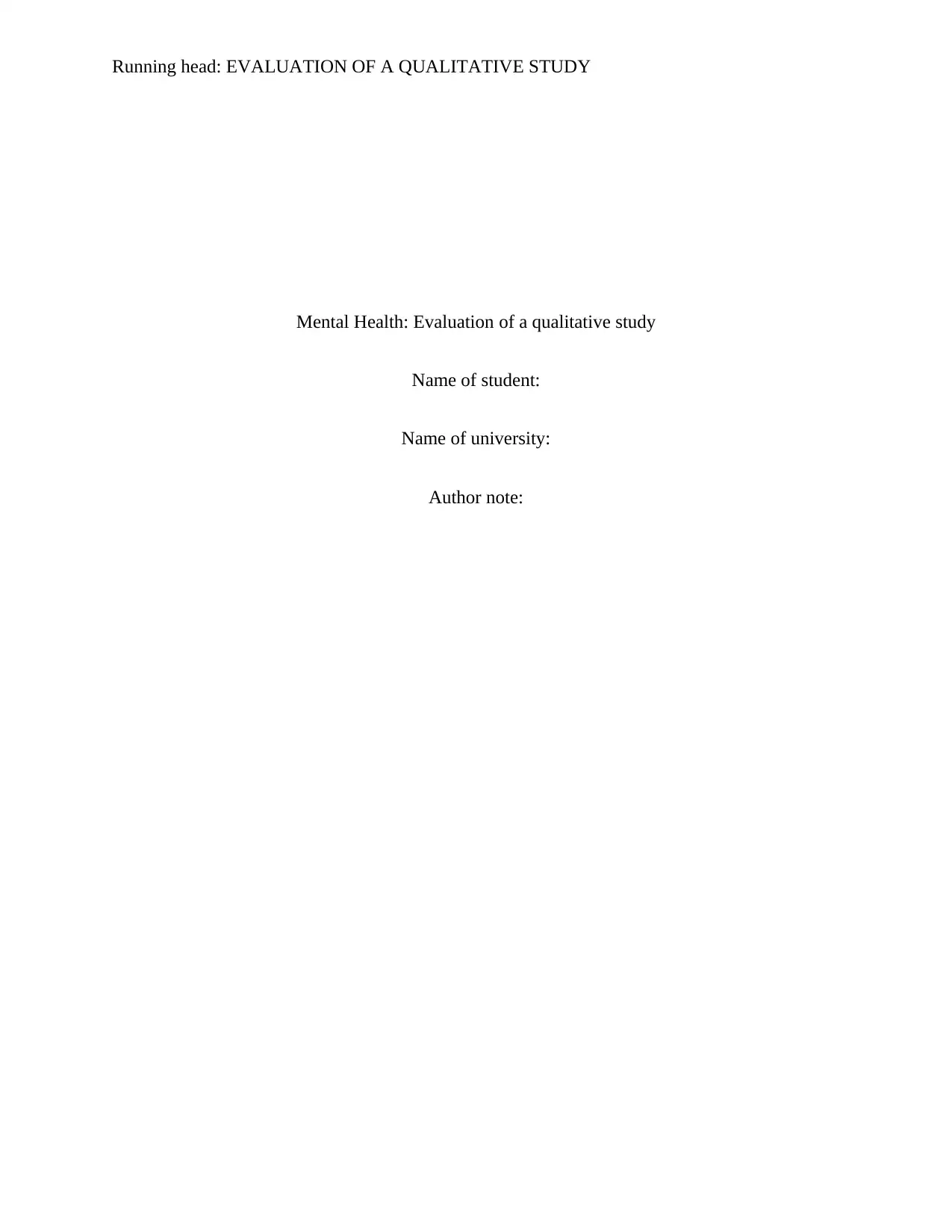
Running head: EVALUATION OF A QUALITATIVE STUDY
Mental Health: Evaluation of a qualitative study
Name of student:
Name of university:
Author note:
Mental Health: Evaluation of a qualitative study
Name of student:
Name of university:
Author note:
Paraphrase This Document
Need a fresh take? Get an instant paraphrase of this document with our AI Paraphraser
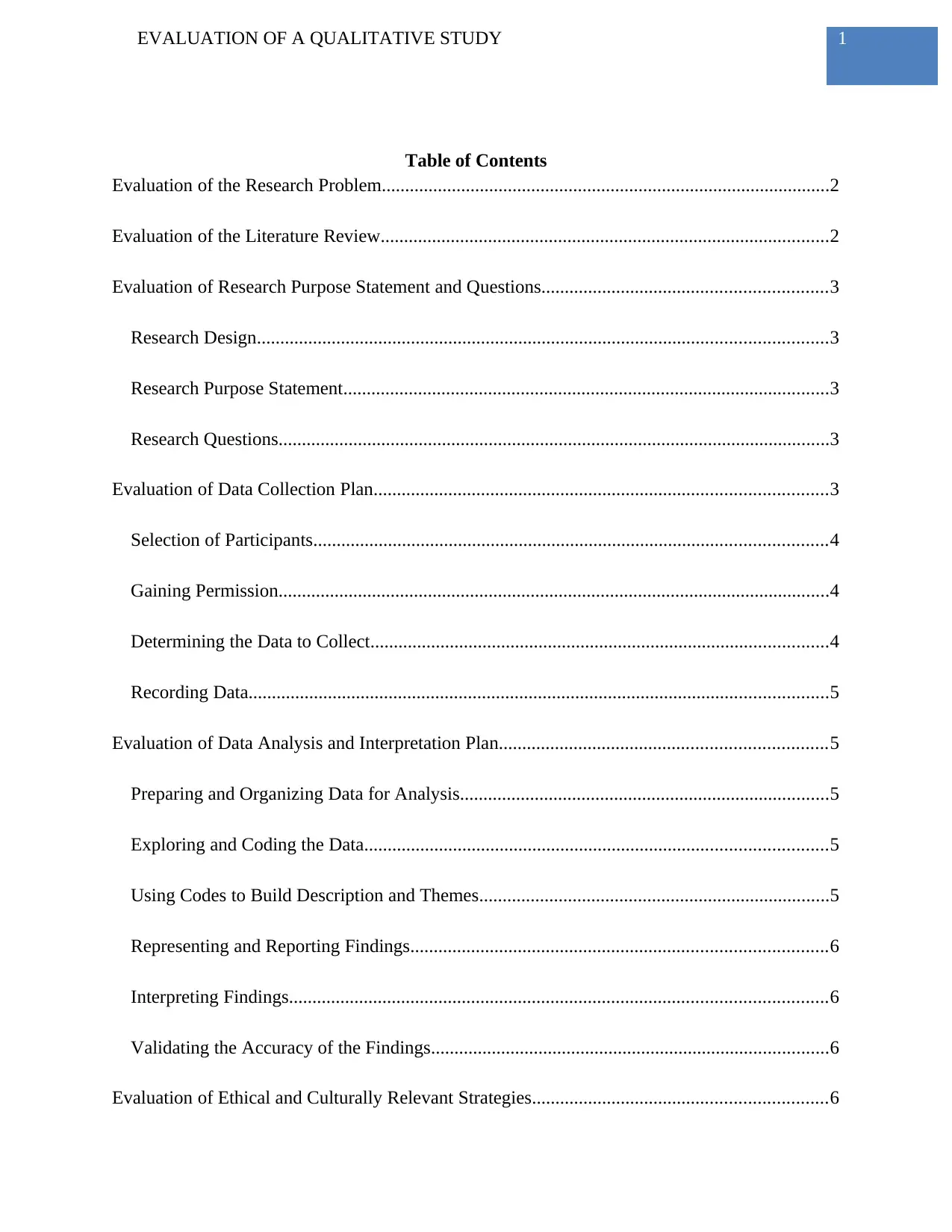
1EVALUATION OF A QUALITATIVE STUDY
Table of Contents
Evaluation of the Research Problem................................................................................................2
Evaluation of the Literature Review................................................................................................2
Evaluation of Research Purpose Statement and Questions.............................................................3
Research Design..........................................................................................................................3
Research Purpose Statement........................................................................................................3
Research Questions......................................................................................................................3
Evaluation of Data Collection Plan.................................................................................................3
Selection of Participants..............................................................................................................4
Gaining Permission......................................................................................................................4
Determining the Data to Collect..................................................................................................4
Recording Data............................................................................................................................5
Evaluation of Data Analysis and Interpretation Plan......................................................................5
Preparing and Organizing Data for Analysis...............................................................................5
Exploring and Coding the Data...................................................................................................5
Using Codes to Build Description and Themes...........................................................................5
Representing and Reporting Findings.........................................................................................6
Interpreting Findings...................................................................................................................6
Validating the Accuracy of the Findings.....................................................................................6
Evaluation of Ethical and Culturally Relevant Strategies...............................................................6
Table of Contents
Evaluation of the Research Problem................................................................................................2
Evaluation of the Literature Review................................................................................................2
Evaluation of Research Purpose Statement and Questions.............................................................3
Research Design..........................................................................................................................3
Research Purpose Statement........................................................................................................3
Research Questions......................................................................................................................3
Evaluation of Data Collection Plan.................................................................................................3
Selection of Participants..............................................................................................................4
Gaining Permission......................................................................................................................4
Determining the Data to Collect..................................................................................................4
Recording Data............................................................................................................................5
Evaluation of Data Analysis and Interpretation Plan......................................................................5
Preparing and Organizing Data for Analysis...............................................................................5
Exploring and Coding the Data...................................................................................................5
Using Codes to Build Description and Themes...........................................................................5
Representing and Reporting Findings.........................................................................................6
Interpreting Findings...................................................................................................................6
Validating the Accuracy of the Findings.....................................................................................6
Evaluation of Ethical and Culturally Relevant Strategies...............................................................6
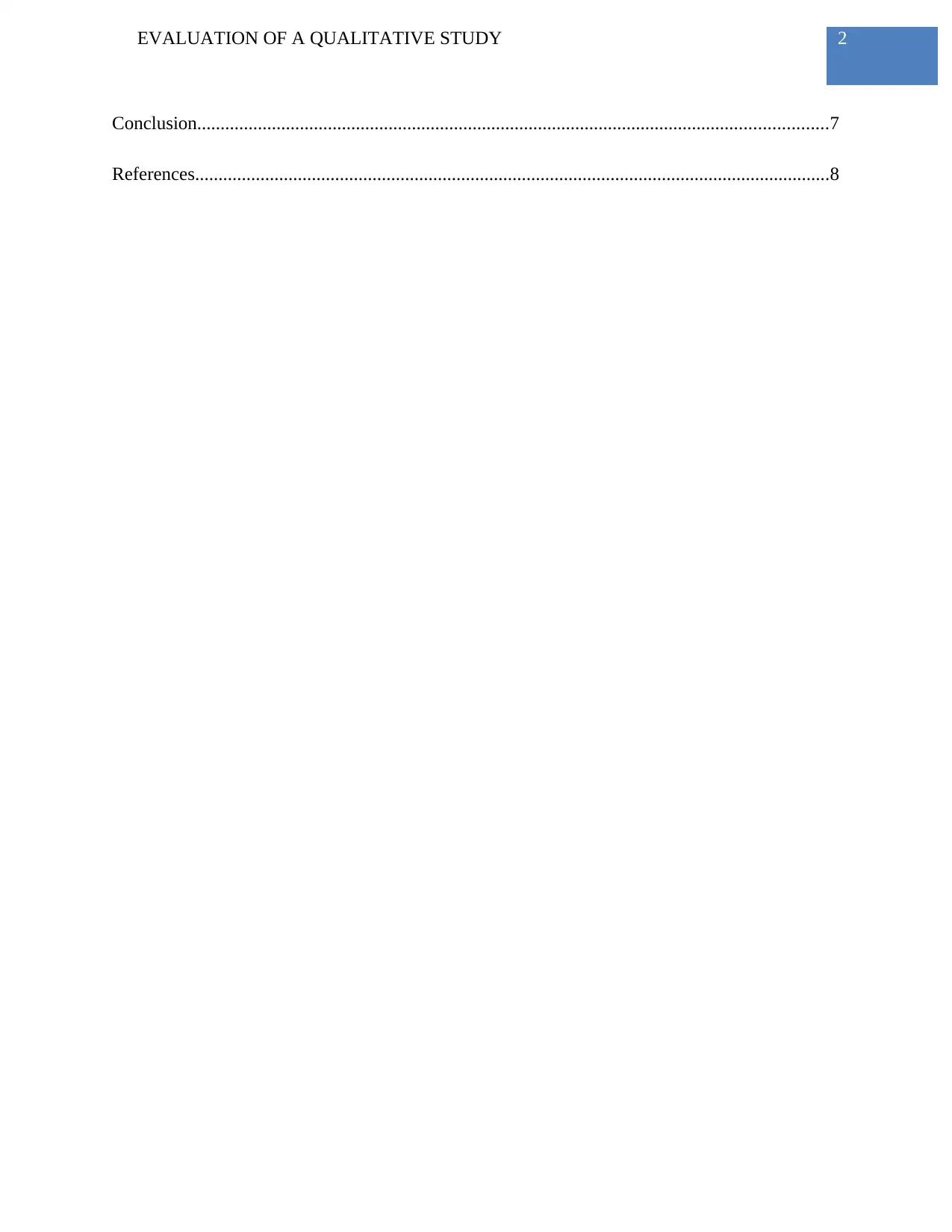
2EVALUATION OF A QUALITATIVE STUDY
Conclusion.......................................................................................................................................7
References........................................................................................................................................8
Conclusion.......................................................................................................................................7
References........................................................................................................................................8
⊘ This is a preview!⊘
Do you want full access?
Subscribe today to unlock all pages.

Trusted by 1+ million students worldwide
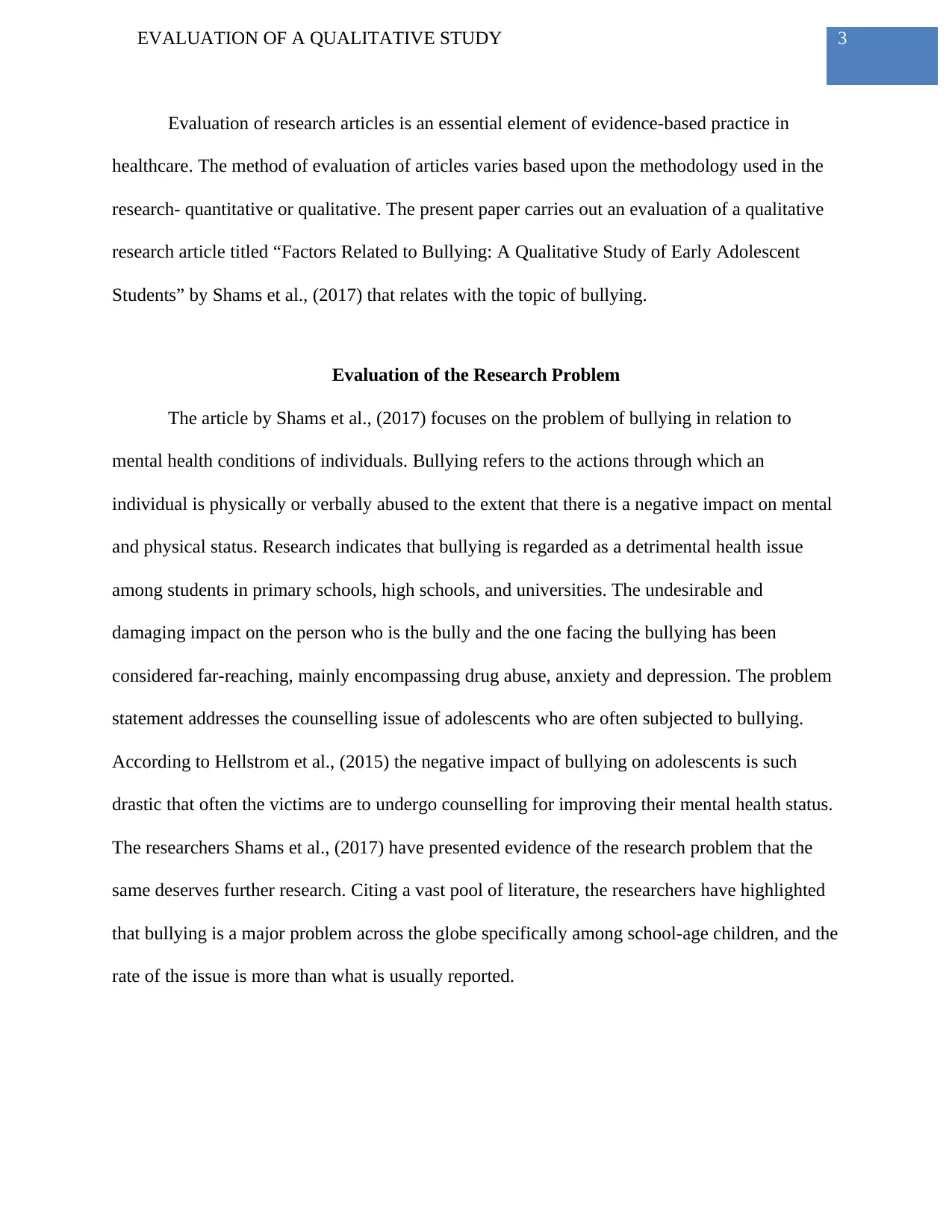
3EVALUATION OF A QUALITATIVE STUDY
Evaluation of research articles is an essential element of evidence-based practice in
healthcare. The method of evaluation of articles varies based upon the methodology used in the
research- quantitative or qualitative. The present paper carries out an evaluation of a qualitative
research article titled “Factors Related to Bullying: A Qualitative Study of Early Adolescent
Students” by Shams et al., (2017) that relates with the topic of bullying.
Evaluation of the Research Problem
The article by Shams et al., (2017) focuses on the problem of bullying in relation to
mental health conditions of individuals. Bullying refers to the actions through which an
individual is physically or verbally abused to the extent that there is a negative impact on mental
and physical status. Research indicates that bullying is regarded as a detrimental health issue
among students in primary schools, high schools, and universities. The undesirable and
damaging impact on the person who is the bully and the one facing the bullying has been
considered far-reaching, mainly encompassing drug abuse, anxiety and depression. The problem
statement addresses the counselling issue of adolescents who are often subjected to bullying.
According to Hellstrom et al., (2015) the negative impact of bullying on adolescents is such
drastic that often the victims are to undergo counselling for improving their mental health status.
The researchers Shams et al., (2017) have presented evidence of the research problem that the
same deserves further research. Citing a vast pool of literature, the researchers have highlighted
that bullying is a major problem across the globe specifically among school-age children, and the
rate of the issue is more than what is usually reported.
Evaluation of research articles is an essential element of evidence-based practice in
healthcare. The method of evaluation of articles varies based upon the methodology used in the
research- quantitative or qualitative. The present paper carries out an evaluation of a qualitative
research article titled “Factors Related to Bullying: A Qualitative Study of Early Adolescent
Students” by Shams et al., (2017) that relates with the topic of bullying.
Evaluation of the Research Problem
The article by Shams et al., (2017) focuses on the problem of bullying in relation to
mental health conditions of individuals. Bullying refers to the actions through which an
individual is physically or verbally abused to the extent that there is a negative impact on mental
and physical status. Research indicates that bullying is regarded as a detrimental health issue
among students in primary schools, high schools, and universities. The undesirable and
damaging impact on the person who is the bully and the one facing the bullying has been
considered far-reaching, mainly encompassing drug abuse, anxiety and depression. The problem
statement addresses the counselling issue of adolescents who are often subjected to bullying.
According to Hellstrom et al., (2015) the negative impact of bullying on adolescents is such
drastic that often the victims are to undergo counselling for improving their mental health status.
The researchers Shams et al., (2017) have presented evidence of the research problem that the
same deserves further research. Citing a vast pool of literature, the researchers have highlighted
that bullying is a major problem across the globe specifically among school-age children, and the
rate of the issue is more than what is usually reported.
Paraphrase This Document
Need a fresh take? Get an instant paraphrase of this document with our AI Paraphraser
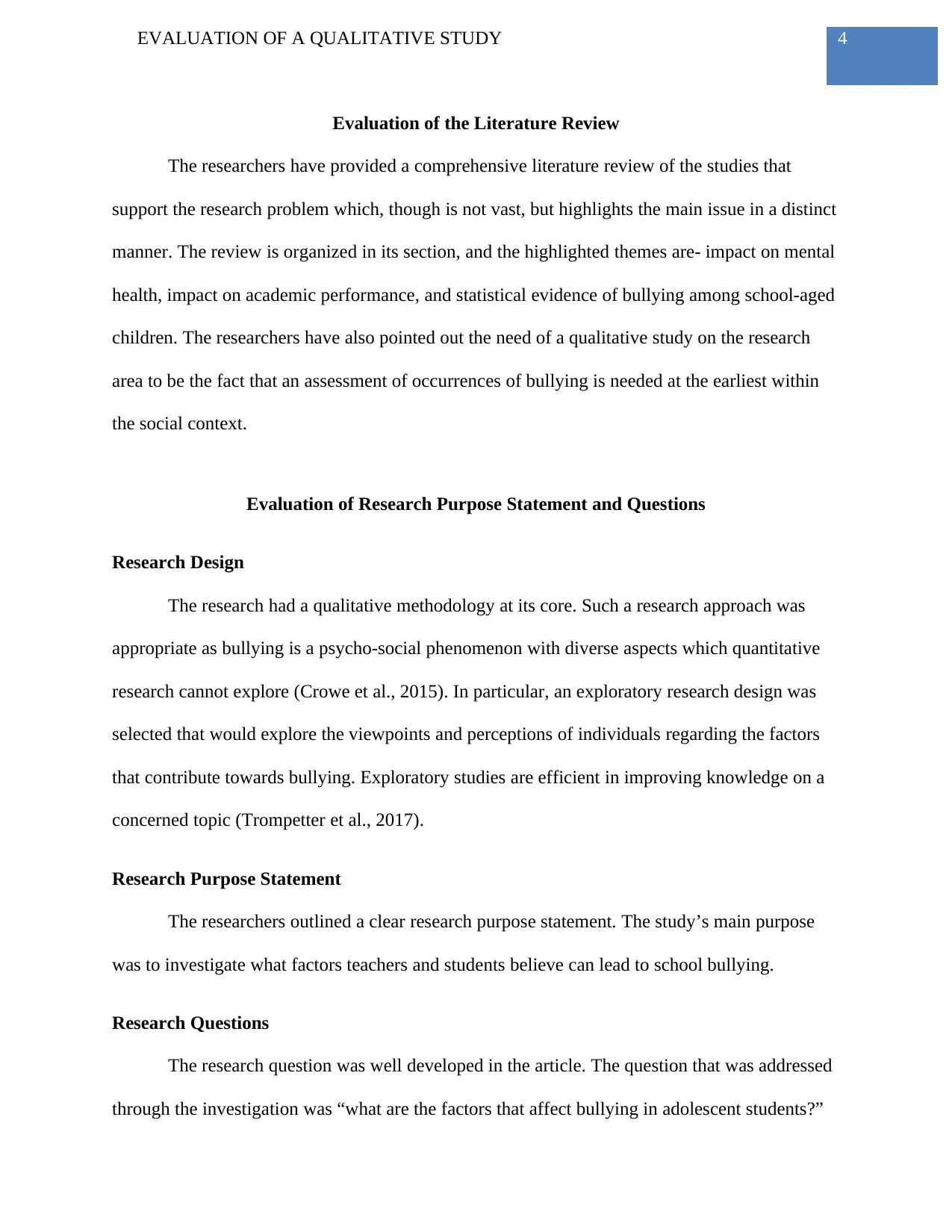
4EVALUATION OF A QUALITATIVE STUDY
Evaluation of the Literature Review
The researchers have provided a comprehensive literature review of the studies that
support the research problem which, though is not vast, but highlights the main issue in a distinct
manner. The review is organized in its section, and the highlighted themes are- impact on mental
health, impact on academic performance, and statistical evidence of bullying among school-aged
children. The researchers have also pointed out the need of a qualitative study on the research
area to be the fact that an assessment of occurrences of bullying is needed at the earliest within
the social context.
Evaluation of Research Purpose Statement and Questions
Research Design
The research had a qualitative methodology at its core. Such a research approach was
appropriate as bullying is a psycho-social phenomenon with diverse aspects which quantitative
research cannot explore (Crowe et al., 2015). In particular, an exploratory research design was
selected that would explore the viewpoints and perceptions of individuals regarding the factors
that contribute towards bullying. Exploratory studies are efficient in improving knowledge on a
concerned topic (Trompetter et al., 2017).
Research Purpose Statement
The researchers outlined a clear research purpose statement. The study’s main purpose
was to investigate what factors teachers and students believe can lead to school bullying.
Research Questions
The research question was well developed in the article. The question that was addressed
through the investigation was “what are the factors that affect bullying in adolescent students?”
Evaluation of the Literature Review
The researchers have provided a comprehensive literature review of the studies that
support the research problem which, though is not vast, but highlights the main issue in a distinct
manner. The review is organized in its section, and the highlighted themes are- impact on mental
health, impact on academic performance, and statistical evidence of bullying among school-aged
children. The researchers have also pointed out the need of a qualitative study on the research
area to be the fact that an assessment of occurrences of bullying is needed at the earliest within
the social context.
Evaluation of Research Purpose Statement and Questions
Research Design
The research had a qualitative methodology at its core. Such a research approach was
appropriate as bullying is a psycho-social phenomenon with diverse aspects which quantitative
research cannot explore (Crowe et al., 2015). In particular, an exploratory research design was
selected that would explore the viewpoints and perceptions of individuals regarding the factors
that contribute towards bullying. Exploratory studies are efficient in improving knowledge on a
concerned topic (Trompetter et al., 2017).
Research Purpose Statement
The researchers outlined a clear research purpose statement. The study’s main purpose
was to investigate what factors teachers and students believe can lead to school bullying.
Research Questions
The research question was well developed in the article. The question that was addressed
through the investigation was “what are the factors that affect bullying in adolescent students?”
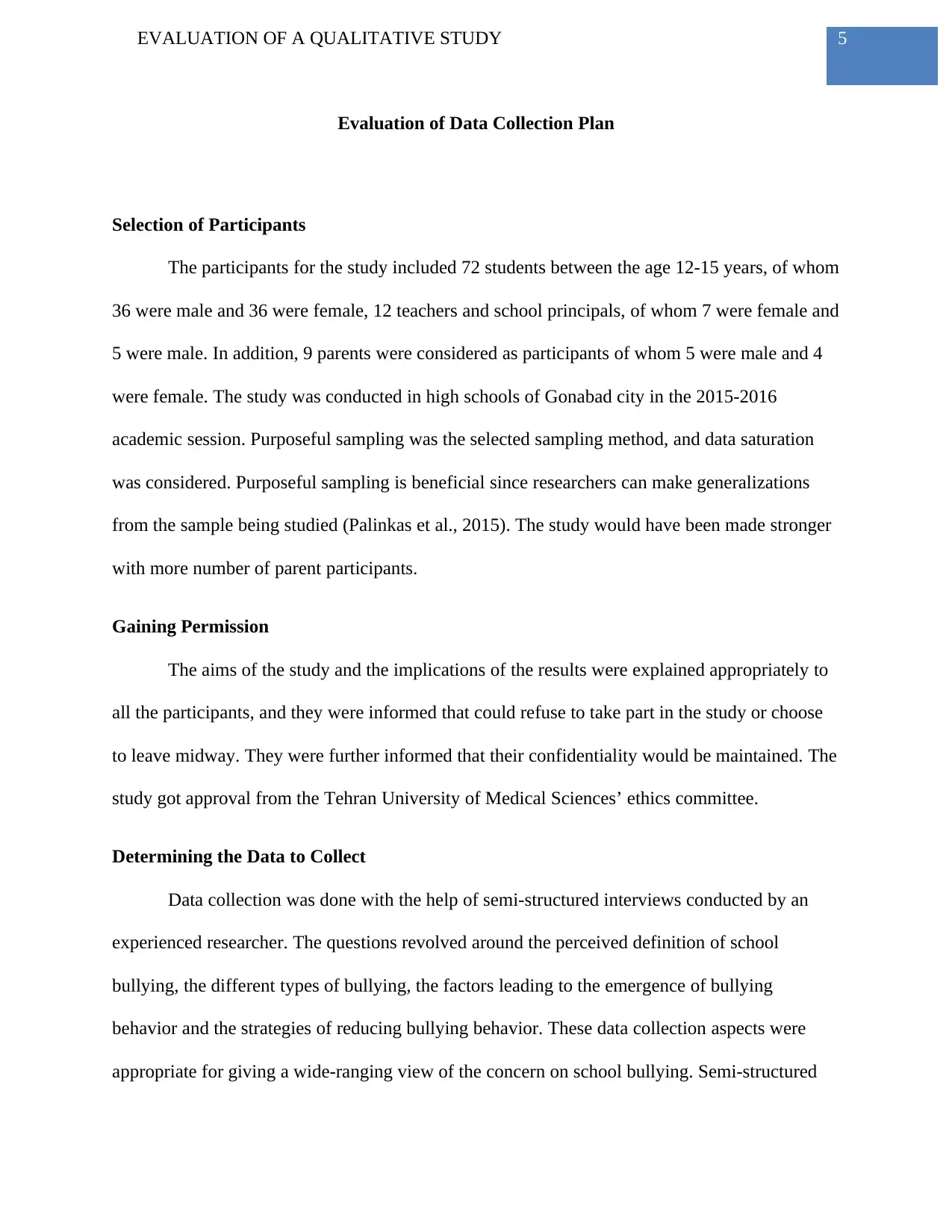
5EVALUATION OF A QUALITATIVE STUDY
Evaluation of Data Collection Plan
Selection of Participants
The participants for the study included 72 students between the age 12-15 years, of whom
36 were male and 36 were female, 12 teachers and school principals, of whom 7 were female and
5 were male. In addition, 9 parents were considered as participants of whom 5 were male and 4
were female. The study was conducted in high schools of Gonabad city in the 2015-2016
academic session. Purposeful sampling was the selected sampling method, and data saturation
was considered. Purposeful sampling is beneficial since researchers can make generalizations
from the sample being studied (Palinkas et al., 2015). The study would have been made stronger
with more number of parent participants.
Gaining Permission
The aims of the study and the implications of the results were explained appropriately to
all the participants, and they were informed that could refuse to take part in the study or choose
to leave midway. They were further informed that their confidentiality would be maintained. The
study got approval from the Tehran University of Medical Sciences’ ethics committee.
Determining the Data to Collect
Data collection was done with the help of semi-structured interviews conducted by an
experienced researcher. The questions revolved around the perceived definition of school
bullying, the different types of bullying, the factors leading to the emergence of bullying
behavior and the strategies of reducing bullying behavior. These data collection aspects were
appropriate for giving a wide-ranging view of the concern on school bullying. Semi-structured
Evaluation of Data Collection Plan
Selection of Participants
The participants for the study included 72 students between the age 12-15 years, of whom
36 were male and 36 were female, 12 teachers and school principals, of whom 7 were female and
5 were male. In addition, 9 parents were considered as participants of whom 5 were male and 4
were female. The study was conducted in high schools of Gonabad city in the 2015-2016
academic session. Purposeful sampling was the selected sampling method, and data saturation
was considered. Purposeful sampling is beneficial since researchers can make generalizations
from the sample being studied (Palinkas et al., 2015). The study would have been made stronger
with more number of parent participants.
Gaining Permission
The aims of the study and the implications of the results were explained appropriately to
all the participants, and they were informed that could refuse to take part in the study or choose
to leave midway. They were further informed that their confidentiality would be maintained. The
study got approval from the Tehran University of Medical Sciences’ ethics committee.
Determining the Data to Collect
Data collection was done with the help of semi-structured interviews conducted by an
experienced researcher. The questions revolved around the perceived definition of school
bullying, the different types of bullying, the factors leading to the emergence of bullying
behavior and the strategies of reducing bullying behavior. These data collection aspects were
appropriate for giving a wide-ranging view of the concern on school bullying. Semi-structured
⊘ This is a preview!⊘
Do you want full access?
Subscribe today to unlock all pages.

Trusted by 1+ million students worldwide
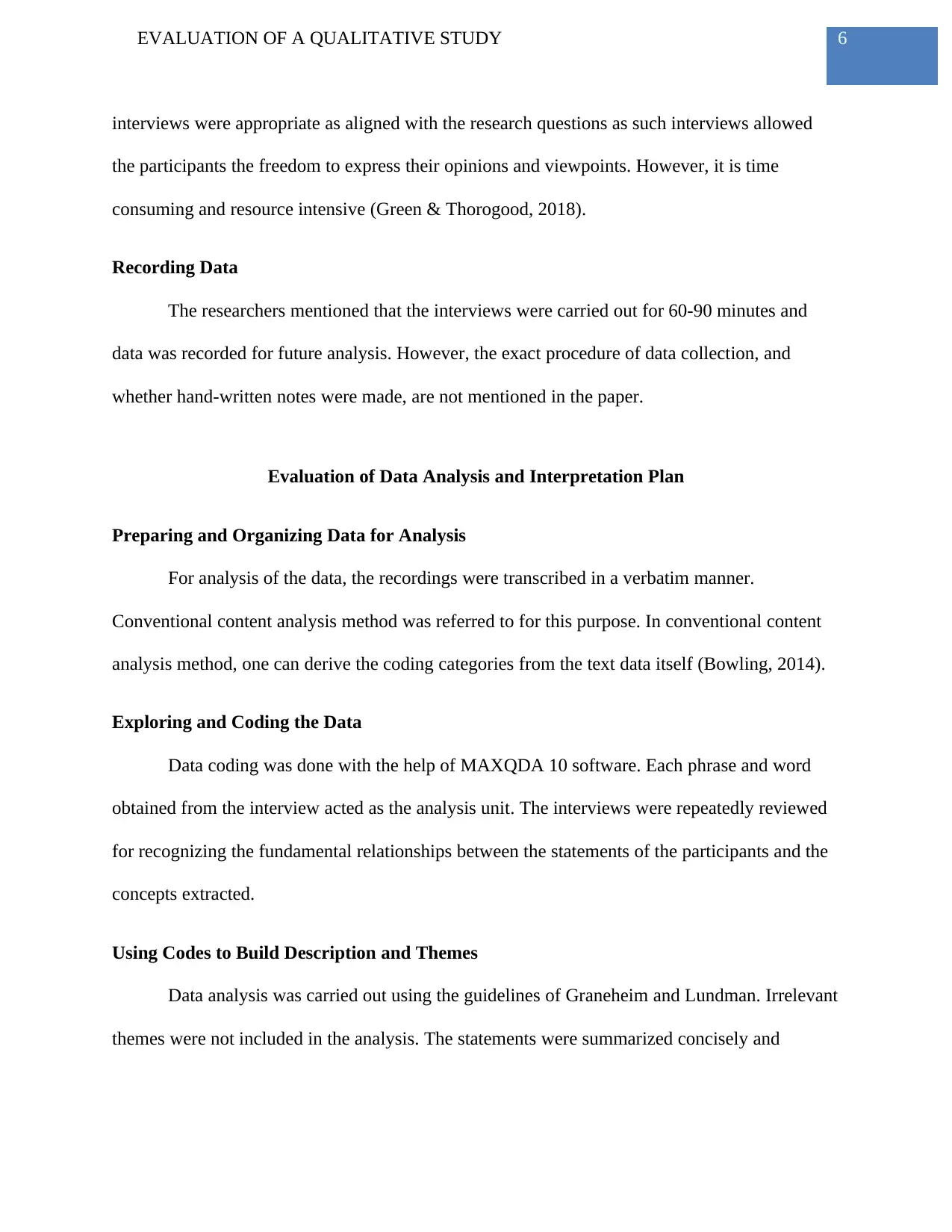
6EVALUATION OF A QUALITATIVE STUDY
interviews were appropriate as aligned with the research questions as such interviews allowed
the participants the freedom to express their opinions and viewpoints. However, it is time
consuming and resource intensive (Green & Thorogood, 2018).
Recording Data
The researchers mentioned that the interviews were carried out for 60-90 minutes and
data was recorded for future analysis. However, the exact procedure of data collection, and
whether hand-written notes were made, are not mentioned in the paper.
Evaluation of Data Analysis and Interpretation Plan
Preparing and Organizing Data for Analysis
For analysis of the data, the recordings were transcribed in a verbatim manner.
Conventional content analysis method was referred to for this purpose. In conventional content
analysis method, one can derive the coding categories from the text data itself (Bowling, 2014).
Exploring and Coding the Data
Data coding was done with the help of MAXQDA 10 software. Each phrase and word
obtained from the interview acted as the analysis unit. The interviews were repeatedly reviewed
for recognizing the fundamental relationships between the statements of the participants and the
concepts extracted.
Using Codes to Build Description and Themes
Data analysis was carried out using the guidelines of Graneheim and Lundman. Irrelevant
themes were not included in the analysis. The statements were summarized concisely and
interviews were appropriate as aligned with the research questions as such interviews allowed
the participants the freedom to express their opinions and viewpoints. However, it is time
consuming and resource intensive (Green & Thorogood, 2018).
Recording Data
The researchers mentioned that the interviews were carried out for 60-90 minutes and
data was recorded for future analysis. However, the exact procedure of data collection, and
whether hand-written notes were made, are not mentioned in the paper.
Evaluation of Data Analysis and Interpretation Plan
Preparing and Organizing Data for Analysis
For analysis of the data, the recordings were transcribed in a verbatim manner.
Conventional content analysis method was referred to for this purpose. In conventional content
analysis method, one can derive the coding categories from the text data itself (Bowling, 2014).
Exploring and Coding the Data
Data coding was done with the help of MAXQDA 10 software. Each phrase and word
obtained from the interview acted as the analysis unit. The interviews were repeatedly reviewed
for recognizing the fundamental relationships between the statements of the participants and the
concepts extracted.
Using Codes to Build Description and Themes
Data analysis was carried out using the guidelines of Graneheim and Lundman. Irrelevant
themes were not included in the analysis. The statements were summarized concisely and
Paraphrase This Document
Need a fresh take? Get an instant paraphrase of this document with our AI Paraphraser
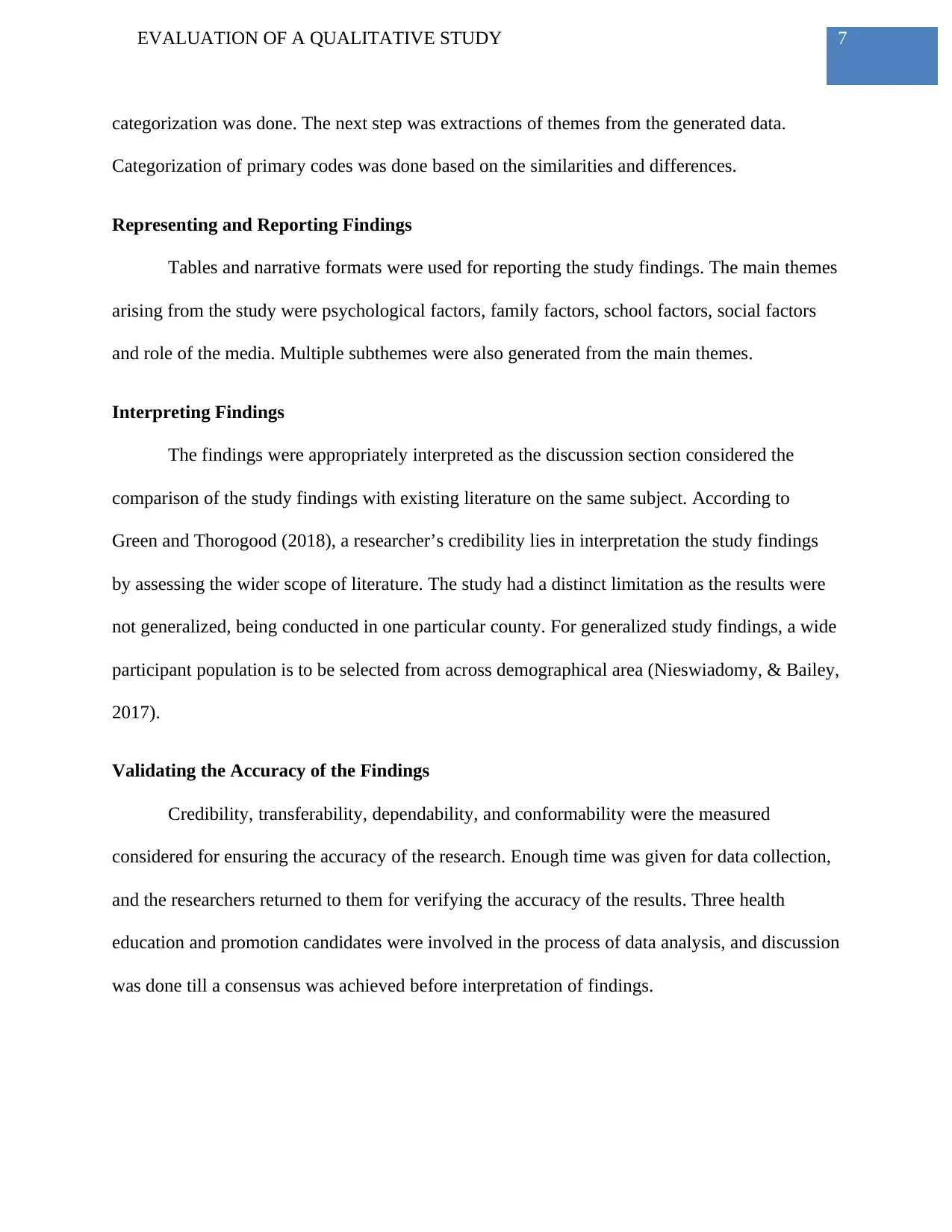
7EVALUATION OF A QUALITATIVE STUDY
categorization was done. The next step was extractions of themes from the generated data.
Categorization of primary codes was done based on the similarities and differences.
Representing and Reporting Findings
Tables and narrative formats were used for reporting the study findings. The main themes
arising from the study were psychological factors, family factors, school factors, social factors
and role of the media. Multiple subthemes were also generated from the main themes.
Interpreting Findings
The findings were appropriately interpreted as the discussion section considered the
comparison of the study findings with existing literature on the same subject. According to
Green and Thorogood (2018), a researcher’s credibility lies in interpretation the study findings
by assessing the wider scope of literature. The study had a distinct limitation as the results were
not generalized, being conducted in one particular county. For generalized study findings, a wide
participant population is to be selected from across demographical area (Nieswiadomy, & Bailey,
2017).
Validating the Accuracy of the Findings
Credibility, transferability, dependability, and conformability were the measured
considered for ensuring the accuracy of the research. Enough time was given for data collection,
and the researchers returned to them for verifying the accuracy of the results. Three health
education and promotion candidates were involved in the process of data analysis, and discussion
was done till a consensus was achieved before interpretation of findings.
categorization was done. The next step was extractions of themes from the generated data.
Categorization of primary codes was done based on the similarities and differences.
Representing and Reporting Findings
Tables and narrative formats were used for reporting the study findings. The main themes
arising from the study were psychological factors, family factors, school factors, social factors
and role of the media. Multiple subthemes were also generated from the main themes.
Interpreting Findings
The findings were appropriately interpreted as the discussion section considered the
comparison of the study findings with existing literature on the same subject. According to
Green and Thorogood (2018), a researcher’s credibility lies in interpretation the study findings
by assessing the wider scope of literature. The study had a distinct limitation as the results were
not generalized, being conducted in one particular county. For generalized study findings, a wide
participant population is to be selected from across demographical area (Nieswiadomy, & Bailey,
2017).
Validating the Accuracy of the Findings
Credibility, transferability, dependability, and conformability were the measured
considered for ensuring the accuracy of the research. Enough time was given for data collection,
and the researchers returned to them for verifying the accuracy of the results. Three health
education and promotion candidates were involved in the process of data analysis, and discussion
was done till a consensus was achieved before interpretation of findings.
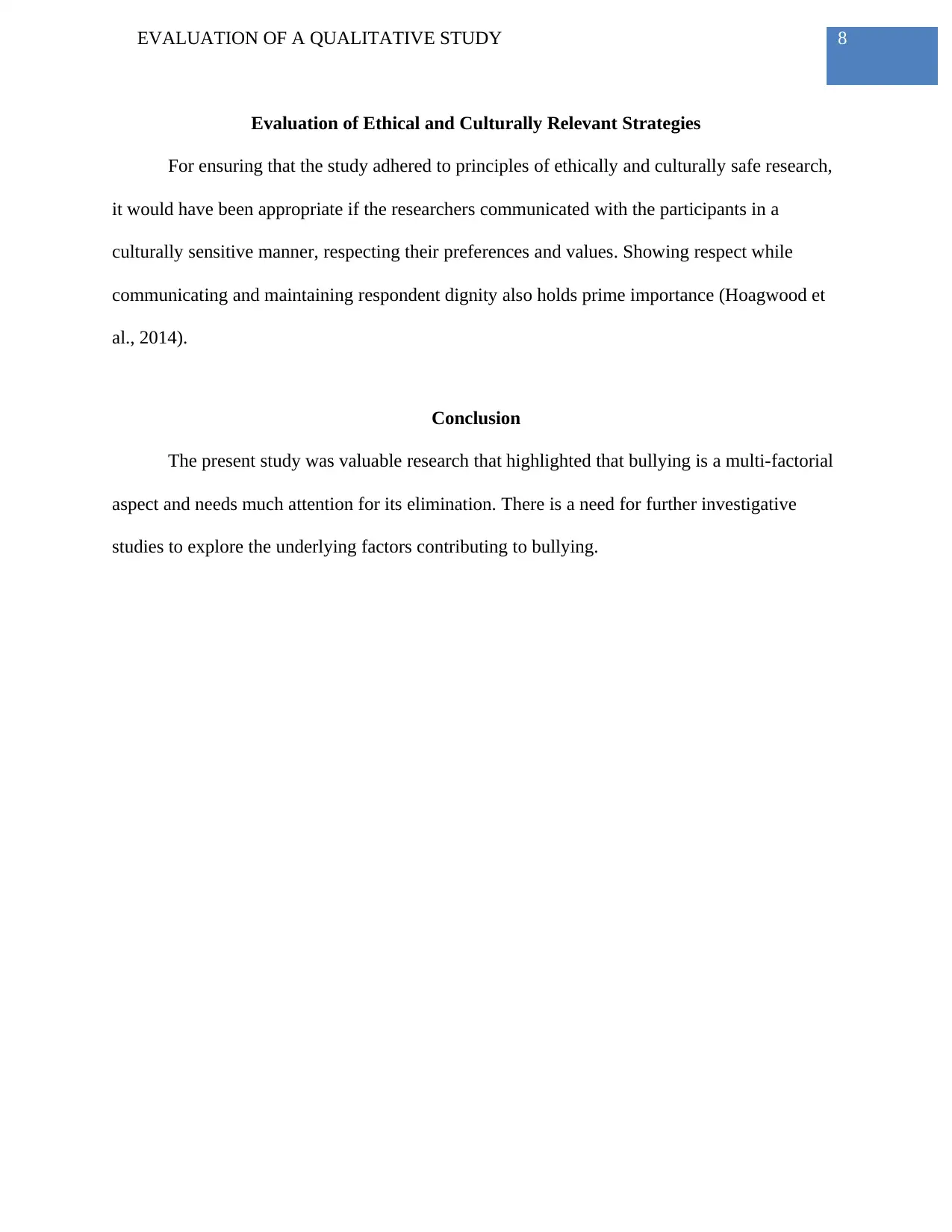
8EVALUATION OF A QUALITATIVE STUDY
Evaluation of Ethical and Culturally Relevant Strategies
For ensuring that the study adhered to principles of ethically and culturally safe research,
it would have been appropriate if the researchers communicated with the participants in a
culturally sensitive manner, respecting their preferences and values. Showing respect while
communicating and maintaining respondent dignity also holds prime importance (Hoagwood et
al., 2014).
Conclusion
The present study was valuable research that highlighted that bullying is a multi-factorial
aspect and needs much attention for its elimination. There is a need for further investigative
studies to explore the underlying factors contributing to bullying.
Evaluation of Ethical and Culturally Relevant Strategies
For ensuring that the study adhered to principles of ethically and culturally safe research,
it would have been appropriate if the researchers communicated with the participants in a
culturally sensitive manner, respecting their preferences and values. Showing respect while
communicating and maintaining respondent dignity also holds prime importance (Hoagwood et
al., 2014).
Conclusion
The present study was valuable research that highlighted that bullying is a multi-factorial
aspect and needs much attention for its elimination. There is a need for further investigative
studies to explore the underlying factors contributing to bullying.
⊘ This is a preview!⊘
Do you want full access?
Subscribe today to unlock all pages.

Trusted by 1+ million students worldwide
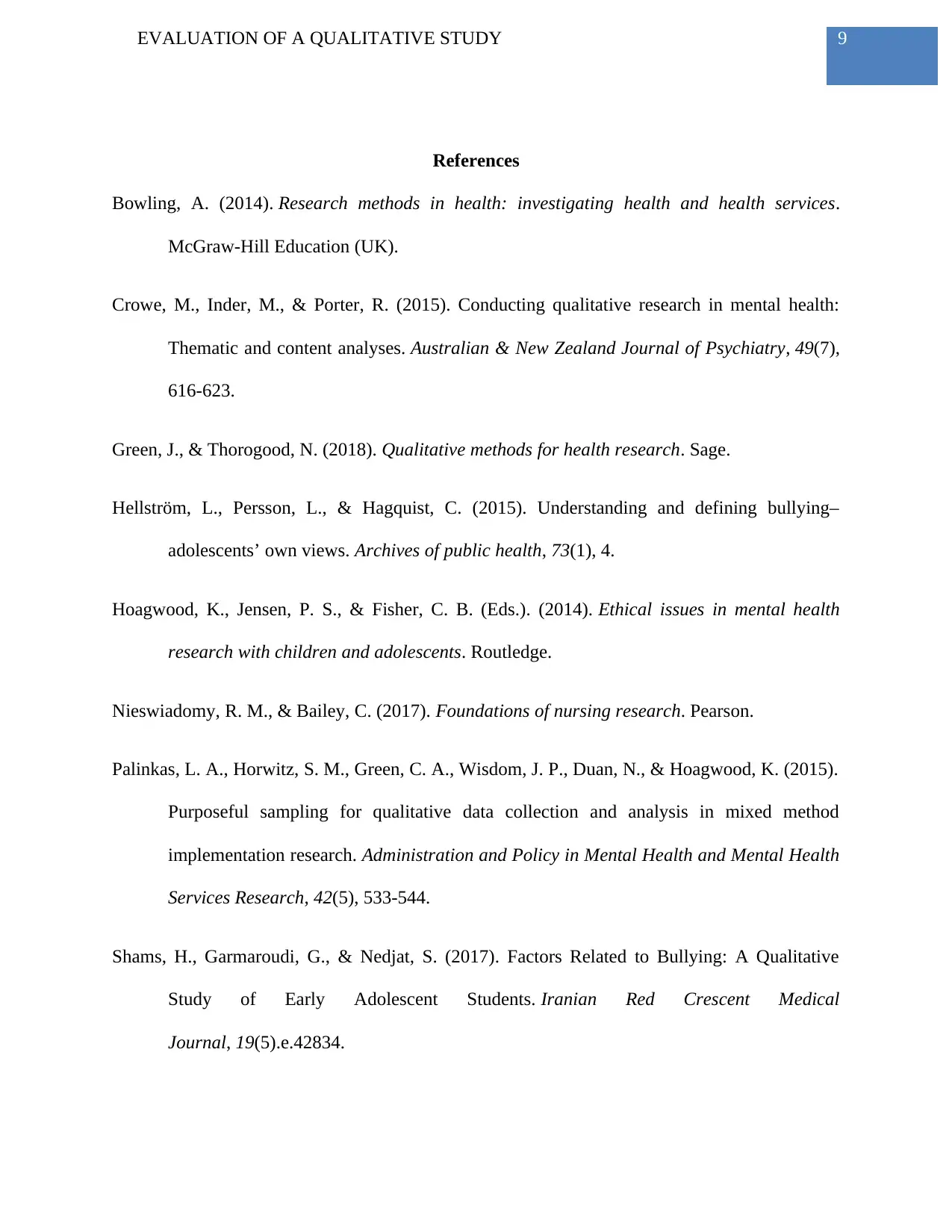
9EVALUATION OF A QUALITATIVE STUDY
References
Bowling, A. (2014). Research methods in health: investigating health and health services.
McGraw-Hill Education (UK).
Crowe, M., Inder, M., & Porter, R. (2015). Conducting qualitative research in mental health:
Thematic and content analyses. Australian & New Zealand Journal of Psychiatry, 49(7),
616-623.
Green, J., & Thorogood, N. (2018). Qualitative methods for health research. Sage.
Hellström, L., Persson, L., & Hagquist, C. (2015). Understanding and defining bullying–
adolescents’ own views. Archives of public health, 73(1), 4.
Hoagwood, K., Jensen, P. S., & Fisher, C. B. (Eds.). (2014). Ethical issues in mental health
research with children and adolescents. Routledge.
Nieswiadomy, R. M., & Bailey, C. (2017). Foundations of nursing research. Pearson.
Palinkas, L. A., Horwitz, S. M., Green, C. A., Wisdom, J. P., Duan, N., & Hoagwood, K. (2015).
Purposeful sampling for qualitative data collection and analysis in mixed method
implementation research. Administration and Policy in Mental Health and Mental Health
Services Research, 42(5), 533-544.
Shams, H., Garmaroudi, G., & Nedjat, S. (2017). Factors Related to Bullying: A Qualitative
Study of Early Adolescent Students. Iranian Red Crescent Medical
Journal, 19(5).e.42834.
References
Bowling, A. (2014). Research methods in health: investigating health and health services.
McGraw-Hill Education (UK).
Crowe, M., Inder, M., & Porter, R. (2015). Conducting qualitative research in mental health:
Thematic and content analyses. Australian & New Zealand Journal of Psychiatry, 49(7),
616-623.
Green, J., & Thorogood, N. (2018). Qualitative methods for health research. Sage.
Hellström, L., Persson, L., & Hagquist, C. (2015). Understanding and defining bullying–
adolescents’ own views. Archives of public health, 73(1), 4.
Hoagwood, K., Jensen, P. S., & Fisher, C. B. (Eds.). (2014). Ethical issues in mental health
research with children and adolescents. Routledge.
Nieswiadomy, R. M., & Bailey, C. (2017). Foundations of nursing research. Pearson.
Palinkas, L. A., Horwitz, S. M., Green, C. A., Wisdom, J. P., Duan, N., & Hoagwood, K. (2015).
Purposeful sampling for qualitative data collection and analysis in mixed method
implementation research. Administration and Policy in Mental Health and Mental Health
Services Research, 42(5), 533-544.
Shams, H., Garmaroudi, G., & Nedjat, S. (2017). Factors Related to Bullying: A Qualitative
Study of Early Adolescent Students. Iranian Red Crescent Medical
Journal, 19(5).e.42834.
Paraphrase This Document
Need a fresh take? Get an instant paraphrase of this document with our AI Paraphraser
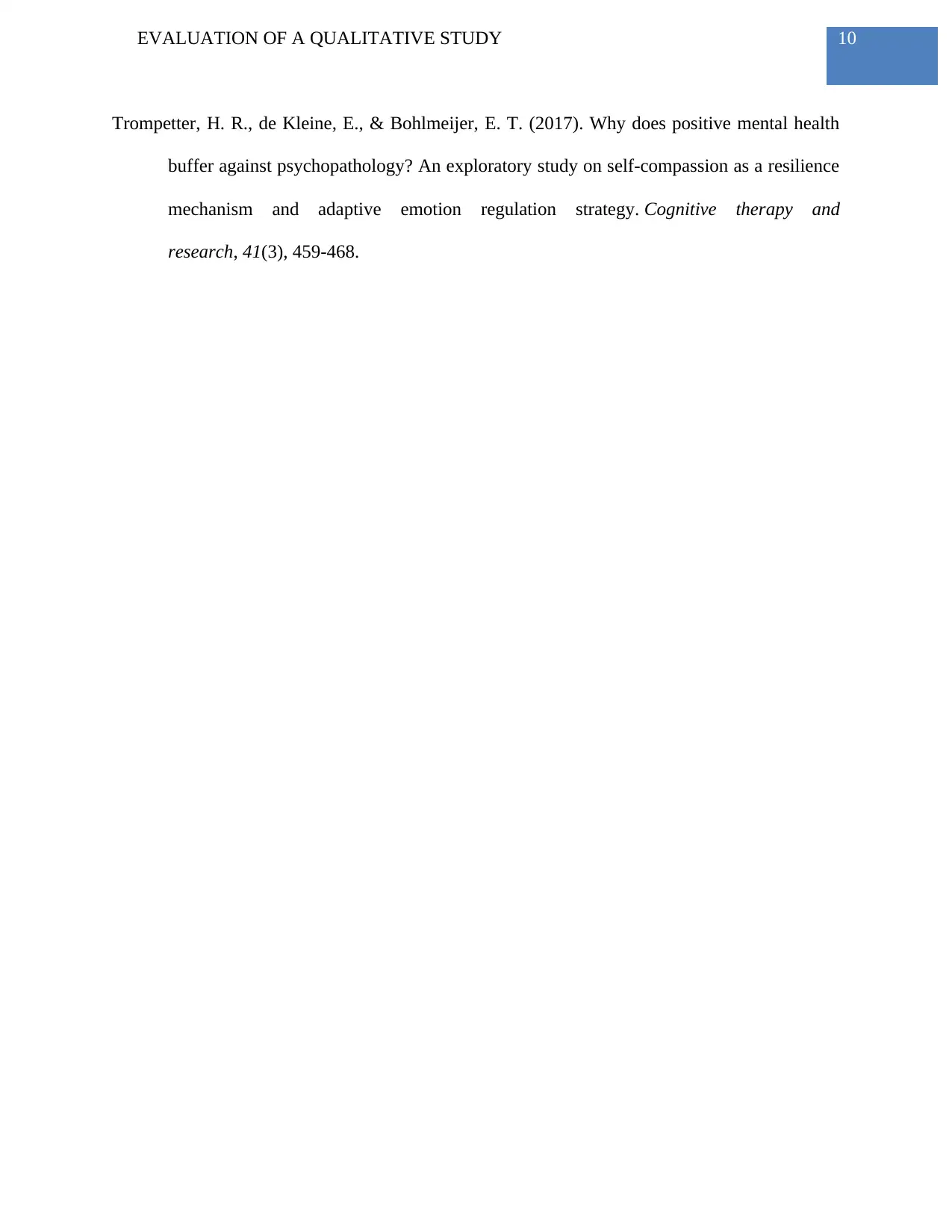
10EVALUATION OF A QUALITATIVE STUDY
Trompetter, H. R., de Kleine, E., & Bohlmeijer, E. T. (2017). Why does positive mental health
buffer against psychopathology? An exploratory study on self-compassion as a resilience
mechanism and adaptive emotion regulation strategy. Cognitive therapy and
research, 41(3), 459-468.
Trompetter, H. R., de Kleine, E., & Bohlmeijer, E. T. (2017). Why does positive mental health
buffer against psychopathology? An exploratory study on self-compassion as a resilience
mechanism and adaptive emotion regulation strategy. Cognitive therapy and
research, 41(3), 459-468.
1 out of 11
Related Documents
Your All-in-One AI-Powered Toolkit for Academic Success.
+13062052269
info@desklib.com
Available 24*7 on WhatsApp / Email
![[object Object]](/_next/static/media/star-bottom.7253800d.svg)
Unlock your academic potential
Copyright © 2020–2025 A2Z Services. All Rights Reserved. Developed and managed by ZUCOL.





